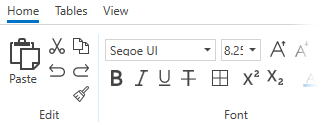RichTextBox for WPF incorporates several themes that allow you to customize the appearance of your grid. When you first add a C1RichTextBox control to the page, it appears similar to the following image:

This is the control's default appearance using C1SimplifiedRichTextBoxToolbar. You can change this appearance by using one of the built-in themes or by creating your own custom theme. All of the built-in themes are based on WPF Toolkit themes. The built-in themes are described and pictured below; note that in the images below, C1SimplifiedRichTextBoxToolbar has been selected to show selected styles:
|
Theme Name |
Theme Preview |
|
C1ThemeBureauBlack |
|
|
C1ThemeExpressionDark |
|
|
C1ThemeExpressionLight |
|
|
C1Blue |
|
|
C1ThemeOffice2007Blue |
|
|
C1ThemeOffice2007Black |
|
|
C1ThemeOffice2007Silver |
|
|
C1ThemeOffice2010Blue |
|
|
C1ThemeOffice2010Black |
|
|
C1ThemeOffice2010Silver |
|
|
C1ThemeShinyBlue |
|
|
C1ThemeWhistlerBlue |
|
|
C1ThemeOffice2013White |
 |
| C1ThemeOffice2013LightGray |
|
|
C1ThemeOffice2013DarkGray |
|
|
C1ThemeOffice2016Black |
|
|
C1ThemeOffice2016Colorful |
|
|
C1ThemeOffice2016DarkGray |
|
|
C1ThemeOffice2016White |
|
|
C1ThemeCosmopolitanDark |
|
|
C1ThemeCosmopolitan |
|
To set an element's theme, use the ApplyTheme method. First add a reference to the theme assembly to your project, and then set the theme in code, like this:
| Visual Basic |
Copy Code
|
|---|---|
Private Sub Window_Loaded(sender As System.Object, e As System.Windows.RoutedEventArgs) Handles MyBase.Loaded Dim theme As New C1ThemeExpressionDark ' Using ApplyTheme C1Theme.ApplyTheme(LayoutRoot, theme) |
|
| C# |
Copy Code
|
|---|---|
private void Window_Loaded(object sender, RoutedEventArgs e) { C1ThemeExpressionDark theme = new C1ThemeExpressionDark(); //Using ApplyTheme C1Theme.ApplyTheme(LayoutRoot, theme); } |
|
To apply a theme to the entire application, use the System.Windows.ResourceDictionary.MergedDictionaries property. First add a reference to the theme assembly to your project, and then set the theme in code, like this:
| Visual Basic |
Copy Code
|
|---|---|
Private Sub Window_Loaded(sender As System.Object, e As System.Windows.RoutedEventArgs) Handles MyBase.Loaded Dim theme As New C1ThemeExpressionDark ' Using Merged Dictionaries Application.Current.Resources.MergedDictionaries.Add(C1Theme.GetCurrentThemeResources(theme)) End Sub |
|
| C# |
Copy Code
|
|---|---|
private void Window_Loaded(object sender, RoutedEventArgs e) { C1ThemeExpressionDark theme = new C1ThemeExpressionDark(); //Using Merged Dictionaries Application.Current.Resources.MergedDictionaries.Add(C1Theme.GetCurrentThemeResources(theme)); } |
|
Note that this method works only when you apply a theme for the first time. If you want to switch to another ComponentOne theme, first remove the previous theme from Application.Current.Resources.MergedDictionaries.